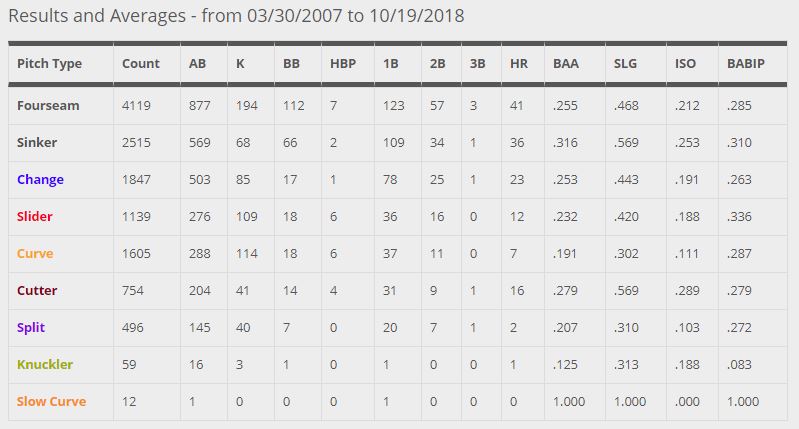(Photo by Leslie Plaza Johnson/Icon Sportswire)
It all came undone in the top of the sixth inning. Houston Astros starter Justin Verlander was pitching good enough to keep his team in the game but looking at the win probability chart below, it was the beginning of the end for their 2018 season.

crude blue dot is Moreland’s double
The Boston Red Sox had Mitch Moreland at the plate. A barely league-average hitter throughout his career, Moreland was no different in 2018. The gameplan looked simple enough; Moreland’s average launch angle up and a little away in the zone was over 30 degrees and ripe for a fly/popout (you’ll see in a bit). But, Moreland is very good against right-handed pitcher fastballs; sinkers in particular (see Chart 1 below).

CHART 1
Moreland is average at best against the four-seam in this case, yet he does have a strong ISO against both pitches.
Verlander starts Moreland off with a fastball that lands middle up (just) above the strike zone. Moreland takes a valiant cut but is late, fouling the ball off of the barrel-meets-handle area of the bat.
[gfycat data_id=”DeliriousFlamboyantGraywolf”]
It’s clear that Moreland is ready for the fastball; Verlander peppers left-handed hitters with his four-seam (Chart 2) with an average velocity of 95 MPH.

CHART 2
You’ll notice something else about his tendencies that should have come into play during this plate appearance. While he still tends to throw the four-seam when ahead, he sometimes mixes in his curveball and has done it well. Can you guess what Moreland is terrible at (see Chart 1)?
In any case, going by Verlander’proclivities, Moreland’s hitter attention should fall between maybe 92 MPH and 85 MPH to cover both the fastball and curveball; those are the two most-thrown to lefties by Verlander. I would guess, just by looking, that’s about what Moreland was timed for on the first pitch. He had to pull his hands in to try to catch up to the pitch that actually arrived (according to Perry Husband and Effective Velocity) at 97 EvMPH. Looking again at the pitch gif above, Moreland is demonstrating what I’ll call a ‘launch angle swing’; slight uppercut swing to lift the ball. Verlander and Martin Maldonado had the right idea; look at Moreland’s launch angle chart and watch the first gif again.

CHART 3
And that right idea was to keep the ball up in the zone and force Moreland into a situation where he likely will pop the ball up for a flyout. However, they made a crucial mistake, at least by EV standards, which I’ll explain in a moment.
For Moreland, as mentioned, he had his attention zone set knowing what velo and pitch to look for. He would also have to be prepared for varied location, as shown by Verlander’s 2018 pitch location chart versus left-handed hitters.

CHART 4
All night, Verlander kept about 66% of his pitches middle/upper zone, most of which was the four-seam. By the sixth inning, Moreland may have been looking for those locations making him even more prepared for the ensuing fallout (strictly guessing here).
With all that in mind, we move on to pitch two; another four-seam up in the zone.
[gfycat data_id=”DeterminedWhirlwindAnemoneshrimp”]
Moreland cracked the fastball with an exit velocity of 98 MPH (87% of his power potential) under a 44-degree launch angle; possibly enough to end up a home run in some parks (the high wall in Minute Maid Park makes it tough to guess). Again, Verlander had the right idea of keeping the ball up as the pitch location fulfilled the launch angle expectations. Except Moreland timed the pitch really well and got the barrel on the ball with good arm extension.
Take a look at the pitch overlay below. Notice how Moreland essentially took the same swing and Verlander (for lack of better explanation) basically threw the ball into his bat.
[gfycat data_id=”ChillyInconsequentialGnatcatcher”]
Observe the freeze-frame picture below; Moreland didn’t have to do anything but make the same exact swing (h/t to @SandyKazmir). While pitch one registered at 94 MPH it was actually 97 EvMPH while pitch two landed in the EV ‘null zone’ (96 MPH, no effect on velocity). This accounts for Moreland not being 100% on-time as he was a few milliseconds late having adjusted his attention to the low-90s on the fastball.

From there, Verlander gave up a single to Ian Kinsler then immediately gave up the game-sealing three-run homer to Rafael Devers. Game over.
What should have happened in this at-bat? Its simple; Verlander was fine throwing the first four-seam fastball but made a big mistake going with that pitch again. This was a perfect situation to attempt to tunnel the curveball with the previous fastball, changing eye-level and velocity enough to disrupt Moreland’s timing. Knowing Moreland doesn’t do much with the pitch, it would make sense, except it looked like Verlander was doing a poor job hiding either pitch behind the other all night; most of his curveballs did what Joe Schwarz of The Athletic St. Louis calls the ‘bunny hop’ out of the tunnel. Instead, he gave Moreland a free pass to second base by being predictable.
As with my last few articles, I’m going on personal assumption here. It’s possible that no matter what Verlander did during this at-bat, Moreland may have reached base. And even if he didn’t its still possible that Boston would have won the game anyway. Regardless, a simple adjustment to the gameplan during this plate appearance could have made the actual result (a little) less likely.
